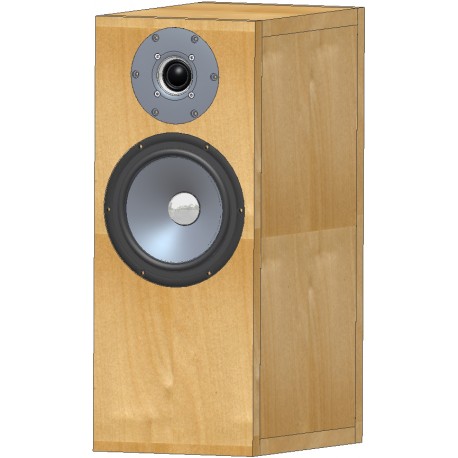










SEAS BIFROST DIY Speaker Kit - selectable crossover componets - Mundorf or Jantzen with or without drivers
SEAS BIFROST DIY Speaker Kit - selectable crossover componets - Mundorf or Jantzen with or without drivers
Set for 2 speakers.
Please select kit options:
Crossover options:
Jantzen Cross-cap capacitors + Jantzen Wire coils 15 and 18AWG + Jantzen MOX Resistors
Jantzen Superior capacitors + Jantzen WAX coils 14 and 16AWG + Superes Resistors
Mundorf MCap EVO Oil capacitors + L140 + L100 coils + MR10 MOX Resistors
Mundorf MCap Supreme EVO Oil capacitors + BL140 + BL100 coils + MREC10 Resistors
Mundorf MCap Supreme EVO Oil capacitors + VLCU15 and VLCU18 coils + MREC10 Resistors
Drivers included:
2 x E0042-08S and 2 x E0040-06 or no drivers
Optional Accessories:
| 014-0409 | Damping Cloth White 350g/m2, by 1m2 | 2 |
| msol.sg-1m | Solder Mundorf M-Solder Silver/Gold 1m | 4 |
| 012-0200 | Jantzen Binding Posts M8 520D Gold, 1 pair | 2 |
| 051-0012 | Port Tube 1-7/8" ID x 5-5/8" L (50/145mm) Flared (HP 900023) | 2 |
Bifrost is a 2-way speaker using the E0042-08 W18NX001 woofer and the E0040-06 T29CF002 tweeter.
Drive units:
The woofer is the SEAS Excel W18NX001 . This driver has a paper cone that is treated on both sides. The front side of the cone is coated with Nextel paint to add somew18nx_klippel_bl.jpg stiffness to the structure, while giving the driver an attractive appearance. The rear side of the cone is also damped with a special coating to further reduce cone resonances.
The voice coil is wound from copper-clad aluminium wire (CCAW) on a non-conductive glass-fiber former. The wire consists of an aluminum core that is covered with a thin layer of copper. The aluminum core reduces voice coil mass considerably, while the thin surface layer of copper allows for conductivity close to that of solid copper wire. The voice coil is generously overhung with a 20mm long winding height in a 6mm air-gap, providing long excursion with low distortion. Even with a large overhang, a correct voice coil rest position is important to ensure stable operation. This is verified using the Klippel Distortion Analyzer LSI measurement.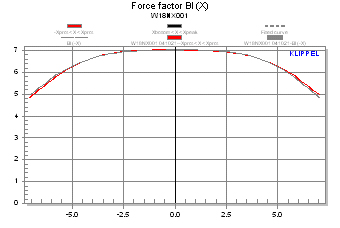
The Excel magnet system has been optimized for low distortion. The T-shaped pole piece has a small extension. This provides excellent symmetry not only in the actual air-gap, but also in the stray fields above and below the air-gap. There are two copper-rings in the magnet system, above and below the air gap. This reduces the voice coil inductance, and improves the inductance symmetry over the excursion range of the driver. The ring on the pole piece also prevents modulation of the magnetic field.
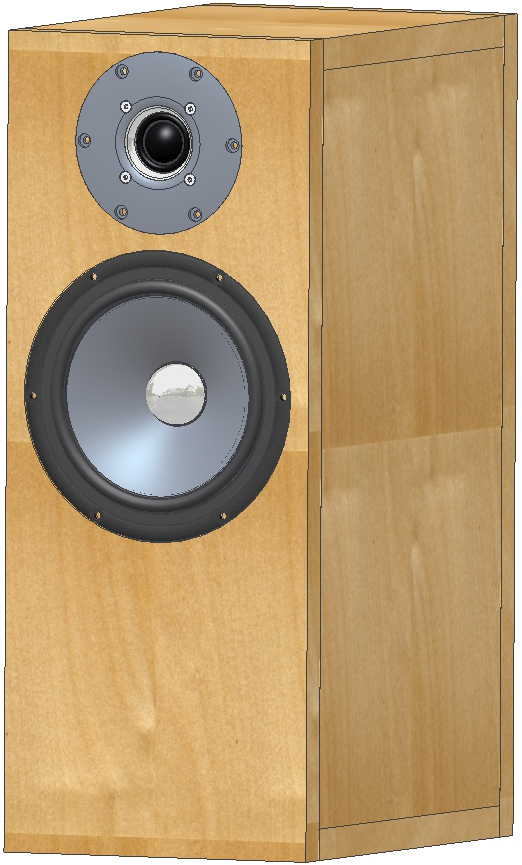
The tweeter is the Excel T29CF002 “Crescendo” . This is a new “state of the art” tweeter from SEAS. The patented Hexadym magnet system first used in the “Millennium” tweeter has been modified with more powerful neodymium magnets, resulting in a tweeter with very high sensitivity and low distortion. The open structure of the Hexadym system provides a free air-path from the sound radiated from the rear side of the dome through the short, but well damped hole in the pole piece. The rear chamber is filled with an absorbing felt pad.
The energy from the backside of the surround also radiates into a secondary chamber created by adding a small air volume between the top-plate and the sub-chassis. This volume is also damped using a foam insert.
The front plate is machined from solid aluminium and coated with Nextel paint. The soft parts are mounted on a separate, field replaceable sub-chassis. The voice coil is wound with a special “high-temp” wire that can handle very high power without burnout. To ensure mechanical reliability, even with a low crossover frequency, the voice coil is attached to the connection terminals using flexible tinsel leads.
The Crescendo uses the same 25mm voice coil diameter as other SEAS 1” tweeters, but the overall radiating area is increased through the use of a wider surround roll. The surround in this tweeter is not just a suspension component. Rather, it has been designed to give a considerable contribution both to the low and high frequency output.
The dome diaphragms are formed in-house, using proprietary equipment and processes.
The basic diaphragm and surround profile was simulated in the FineCone program from Loudsoft. This FEM based software allows one to study how a diaphragm structure behaves over a specific frequency range. However, we cannot say that designing the Crescendo dome was accomplished by just punching some numbers into a computer. The design has been refined through hundreds of hours, with fine adjustment of the diaphragm forming tools, and a long process of developing a pre-coated textile material with the right properties. We have named the new textile Sonomex.
The combination of low moving mass, high force factor, and low resonance frequency results in a moving system with low Qts. The sloping response below 3 kHz confirms this. When developing the Bifrost kit, we discovered that the peak in the response caused by baffle edge diffraction was not as prominent as on drivers that measure flat in the test baffle we normally use for datasheet measurements. A normal rectangular loudspeaker box with a 20cm wide baffle with the tweeter centered on the width and offset towards the upper edge of the front baffle will provide significant gain in the region from 1 to 2 kHz, caused by the edge diffraction effects. So in this case, the sloping response of the Crescendo tweeter made the crossover simpler to design.
Enclosure design:
The woofer T/S parameters are found in the datasheet. This data was entered into the driver editor in the LspCAD software from IJdata. Using the “Table Lookup Optimizer” with 0.3ohms entered as added series resistance (dc resistance of inductor in series with the woofer) the QB3 alignment suggests a box volume of about 14 liters. We have instead chosen to make the box a bit larger than this and aim for an EBS alignment. The simulation shows the frequency response in a cabinet volume of 18 liters, with a port tuning at 42 Hz.
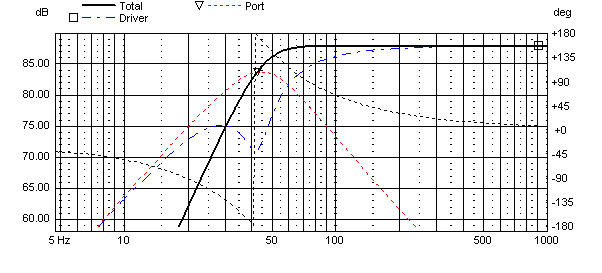
The simulated –3dB frequency in half-space is 45Hz.
To find the bass response most suitable for your room, we encourage you to experiment with both placement of the loudspeaker in the room and possibly also the port tuning.
We used a port with an inner diameter of 6cm and 18cm length. If you only can find ports with 5cm ID, the length should be 12cm, but the smaller area will lead to quite high airspeed in the port and possibly problems with chuffing noise. A port with ID 7cm should be 25cm long, but it will leave only 2.9cm from the port to the inside of the front baffle. A bent port might be a solution.
The box is constructed with a narrow front baffle. The internal box dimensions have a ratio of 1:1.6:2.8. This is done to distribute the internal standing waves over a broad frequency range. The box has two horizontal braces with large window openings. This divides the large side panels into smaller sections. The panel resonances of these sections are also distributed over a broader frequency range, and they can be more effectively attenuated through the use of e.g. bitumen pads.
There is 140grams of Acousto-Q stuffing inside the box. The stuffing was distributed in the two sections formed by the braces in the mid- to upper part of the box. The section where the port enters is kept open to allow a free airflow through the port.
Crossover network:
The crossover is developed with the help of the LspCAD simulation software from IJdata.
The drivers were measured in the box and the data was imported into the software to be used as a basis for the simulation.
Both drivers were measured with the microphone placed 1meter from the front baffle, centered on the tweeter axis. This way we get a precise measure of the phase difference due to different propagation time from the two drivers. With frequency, phase, and impedance imported into the software, it’s quite easy to determine which network topology to use to get a good crossover summation.
The crossover was developed empirically, without confinement to the traditional textbook filter formulas. The drivers should be in phase at the crossover frequency, and the sum should be flat when both drivers are at –6 dB relative to the pass band level. Now the inevitable vertical off-axis cancellation, which is always present with the use of non-coincident drivers, is at least outside the listening axis (tweeter axis).
To accomplish this it was necessary to use a 2nd order electrical network in the high pass section and a 3rd order network for the low pass. Both drivers should be connected with the same polarity.
As you will see from the measurements below, there is a slight step in the axial frequency response above 2 kHz. This is a result of an adjustment made after some listening evaluation.
The first prototype of the Bifrost measured flat above 2 kHz, but we found the sound image too intense. Measurements showed a peak in the off axis response caused by the difference in directivity between the woofer and the tweeter in the crossover region. By starting the tweeter roll-off a bit earlier, the off axis response is better and the sound is smoother and more natural.
The crossover frequency is 2.2 kHz.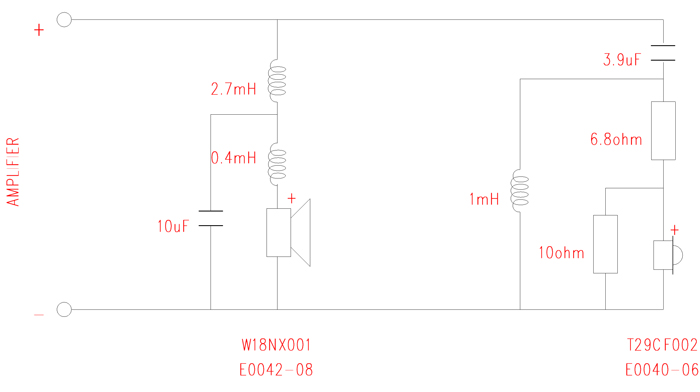
Measurements:
The measurements are done in a free-field anechoic chamber at 1 meter on tweeter axis with an input voltage of 2.83 volts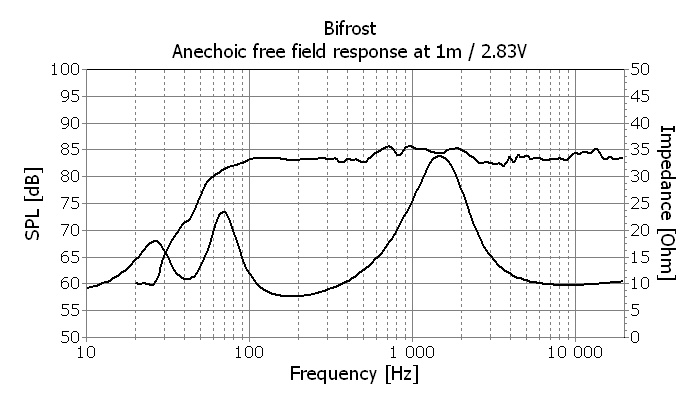
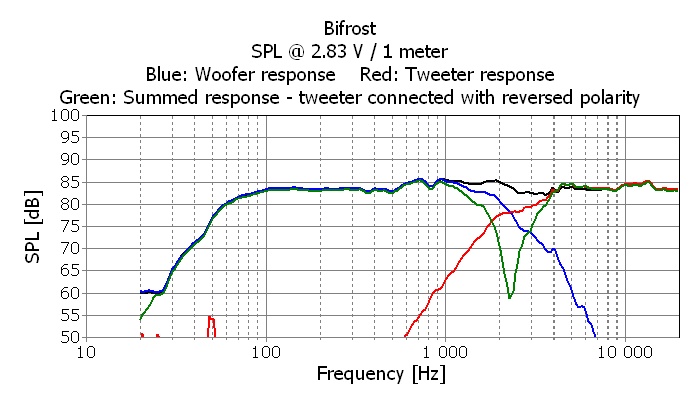
The green curve shows the system response with the tweeter connected with reversed polarity.
The cancellation confirms that the drivers are in phase around the crossover region.
The system sensitivity is considerably lower then what is found in the two driver’s datasheets. This is intentional, and necessary to compensate for the so called “baffle step / spreading loss”. For further information see: http://www.t-linespeakers.org/tech/bafflestep/
Average sensitivity is 84dB SPL @ 1 meter with an input voltage of 2.83 volts.
The measured axial frequency response variation is +/- 2dB between 71 Hz and 22 kHz.
Minimum impedance is 7.5 ohm at 180 Hz.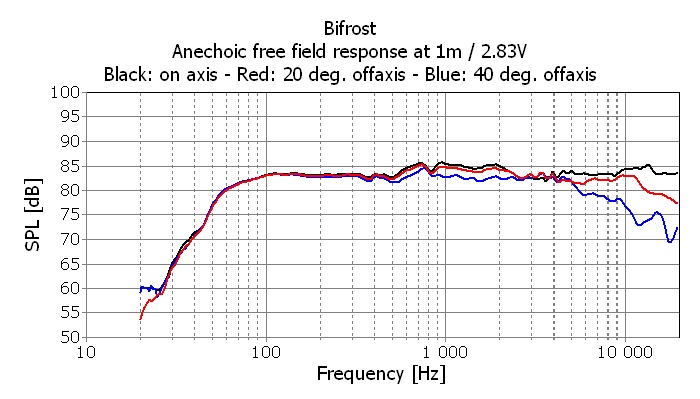
The horizontal off-axis plots show a smooth response for the axial, as well as 20 and 40 degree angles. 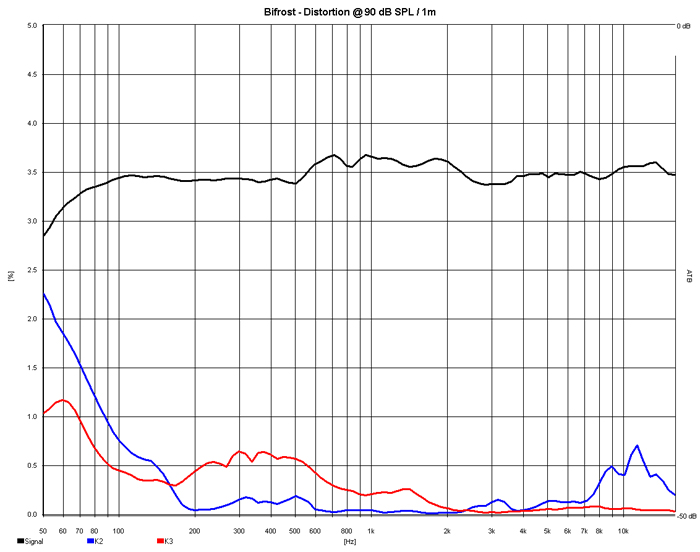
Distortion at 90 dB SPL / 1 meter. Blue: 2.nd harmonic - Red: 3.rd harmonic.
High quality components results in a system with low distortion.
For users with simulation tools that wish to make adjustments to the crossover, or use the data for other purposes, we have made the raw driver response in the Bifrost cabinet available for download - see Downloads tab.
Teile võib meeldida ka